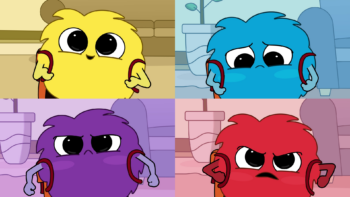
Earlier in the year, I was invited to give a talk to some soon-to-be animation graduates at my old university, RMIT. The topic I talked about? “Transitioning from your studies to the animation industry”.
Basically – everything that I was told and wished I had been told when making that scary jump into the real world.

Leaving your studies and heading into the animation industry for the first time can be terrifying, confusing, and nerve-wracking – and don’t believe anyone who tells you otherwise. But it’s also exciting! So here are some of the tips I shared on how to better prepare you for all that exciting work you’ll soon be doing!
One. Brand yourself
Our job as animators and designers is to create products for companies so they can convey their brand identity to their consumers. Likewise, when you are selling yourself to YOUR consumer ie. potential employers or clients, you want to have a solid personal brand. This means knowing and establishing your brand’s visual identity and voice, as the way you present yourself and your work will attract potential clients differently. Are your visuals dark and sleek with sophisticated language or bright and poppy with relatable slang?
These branding elements could be applied to personal websites, social media, showreels – basically anything out there with your professional identity! And speaking of getting yourself out there…
Two. Promote yourself
When clients or employers are given your name to look up, they will want to see your socials, website, showreel, and portfolio. So make sure these are all up to date and show your best work.
9 times out of 10, employers will make a majority of their hiring decisions based on what they see in your showreel/portfolio, so it must be attention-grabbing, engaging, and communicative. Think about what strategy you want to use depending on your needs – such as applying for specific positions, which may require more targeted portfolios, vs. a generalised showreel for a wide catchment of viewers.

Three. Strategise your career
Have a bit of a career plan, or even just be aware of your options. Do you like self-managing and want flexibility, where freelancing may be the best option for your lifestyle? Or do you thrive when working in teams and having structure, in which case is working in a creative studio a better suit? Or will you want to jump from one to another?
Depending on your field of animation or design, you may need to plan differently. TV production is most often employed on short contracts, while commercial motion graphics jobs at studios could offer permanent positions.
Will you also want to only remain as a creative, or will you eventually want to work as a producer, director, supervisor, etc.? There are lots of avenues you could take, but being aware of these routes and their pitfalls or advantages is never going to be a bad idea. And by researching these routes, you may find yourself talking to different people, which leads us to our next point…
Four. Establish your network
Make (and keep) friends in the industry! The best resource you can have (besides your own skills, of course) is a network of friends who can not only offer support, encouragement, and guidance, but also recommendations and notifications for jobs.
Attend local industry meetups and events; keep in touch with teachers and classmates from university, reach out to creatives you admire via social media. Of course, this isn’t a one-way street! If you want support, offer support in return. Pay any kindness you’ve received forward to the next person who may need it.
Five. Continue to develop your skills
How can you expect to improve and get better jobs if you’re not putting in the hard yards? If you’re not continuing to learn right up until the end of your career, you’re doing something wrong. This could mean practising drawing, researching current trends, exploring new mediums, or just generally honing your existing skills.
So many online tutorials and courses exist nowadays, some paid and many for free. It may be through this poking around that you discover your next creative calling!
Six. Be resilient
As fun as this work can be, the animation industry is a tough one.
Rounds and rounds of feedback from both colleagues and clients, grind periods and short deadlines; difficult clients; having difficulty finding work; the instability of contracts; and even more mundane things such as navigating taxes and maintaining your equipment. These are all going to be challenges, but no industry is without any. Learn to be resilient, leave your ego at the door, and assume that there will be some bumps in the road.
Nevertheless, take care of yourself! There’s a line between working hard vs. burnout, receiving criticism vs. coping abuse; persevering vs. being persistent to the point of self-destruction. A job may only last a short time, but your wellbeing will be with you for a long time.

Seven. Keep an open mind!
This industry is an ever-evolving one, and you’ll experience lots of new things and ideas. Don’t trap yourself in a box and deny new experiences or opportunities just because they’re outside of your comfort zone or expectations.
To leave this blog post with a personal anecdote, I primarily studied hand-drawn 2D animation in university. But I taught myself motion graphics, and am learning 3D animation and modelling and projection mapping during my professional development at Creativa Animation Studio. I never would have expected to want to learn such things, but was inspired after being exposed to the work my colleagues were doing, because of Creativa’s involvement in lots of different innovative mediums.
So while the transition between studies and the animation industry can be difficult and scary, it’s also rewarding in the lessons it can teach you. Hopefully all of you out there who are making a similar transition can enjoy the exhilaration this jump can give you!
Would you like to take a look at some of my best animation work at Creativa?




